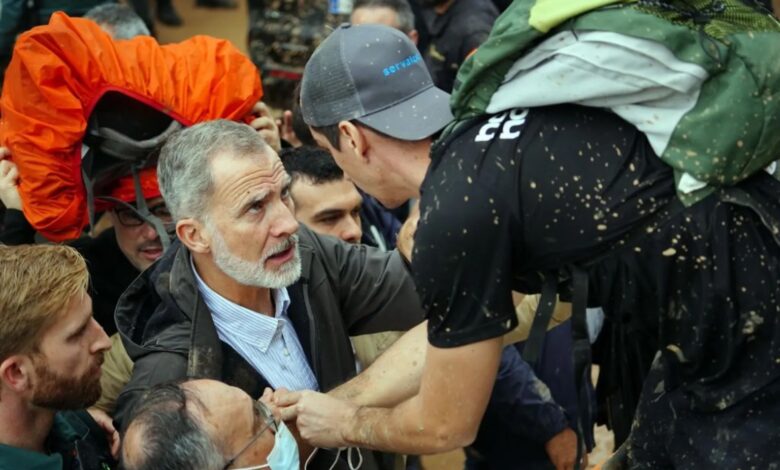
Spain’s King and Queen Face Mud Attack in Flood-Stricken Valencia
Angry residents threw mud at Spain’s king and queen during their visit to flood-ravaged Valencia. This rare show of public defiance against King Felipe VI and Queen Letizia happened as they toured the devastated areas. The whole ordeal revealed growing frustrations between flood victims and officials regarding slow relief efforts.
The royal couple visited Valencia after devastating floods caused massive destruction in the region. Thousands of residents lost their homes, and the floods severely damaged the area’s strong infrastructure. Local officials still work to determine the flood’s full impact while emergency teams continue their response.
Devastating Floods in Valencia
Spain faced its deadliest natural disaster in decades when devastating floods hit Valencia and let loose unprecedented destruction throughout the region. A catastrophic weather system poured 20 months’ worth of rain in just eight hours. The infrastructure couldn’t cope, and residents had no time to prepare.
The floods’ effects have devastated communities, with emergency services confirming 205 deaths, most of them in Valencia. Communities now struggle with several challenges:
- Power outages affecting thousands of homes
- Collapsed bridges and destroyed rail tracks
- Streets blocked by debris and mud
- Communities cut off from basic services
- Over 1,300 people reported missing
Spanish authorities launched their largest peacetime security operation. Thousands of soldiers and police officers joined rescue teams. Many areas remained inaccessible because of collapsed roads, which prevented emergency services from reaching isolated communities.
Paiporta bore the brunt of destruction with 62 deaths. Local residents watched helplessly as cars floated by with people trapped inside. A nearby nursing home lost six residents even though staff tried desperately to move elderly patients to higher floors.
Valencia’s regional government has restored power to 90% of affected areas. Many communities still lack reliable phone service and running water. This catastrophe raised serious questions about warning system effectiveness. Many residents said they received emergency alerts only after flood waters had already surrounded their homes.
Royal Visit Turns Chaotic
A royal visit to Paiporta turned chaotic when hundreds of angry residents confronted King Felipe VI and Queen Letizia as they inspected flood-damaged areas. Protesters threw mud, eggs, and various objects at the royal couple and their entourage. Security personnel had to shield them with umbrellas quickly.
The angry crowd showed their hostility through:
- Loud chants of “murderers” and “get out”
- Demonstrators wielding shovels and poles
- Objects thrown at official vehicles
- Damage to the Prime Minister’s car
The confrontation left Queen Letizia with mud on her face and clothes, yet she tried to console distraught residents. Two royal bodyguards sustained injuries during the whole ordeal. One guard had a visible wound on his forehead.
Security teams evacuated Prime Minister Pedro Sanchez and Valencia region head Carlos Mazon from the scene. King Felipe managed to keep his composure and lowered his umbrella to hear residents’ grievances. The monarch spent nearly an hour trying to calm tensions before authorities ended up suspending the remaining planned visits to flood-affected areas.
This unprecedented show of public anger revealed the locals’ growing frustration. They noticed delayed emergency alerts and poor crisis response from authorities. High tensions across the region led to the cancelation of a scheduled visit to nearby Chiva.
Security Concerns and Political Fallout
Valencia’s flood crisis has exposed deep tensions between regional and federal authorities. Poor coordination between Valencia’s regional government and Madrid created delays in relief efforts. Emergency funds got stuck in bureaucratic red tape. Both President Carlos Mazon and Prime Minister Pedro Sánchez drew criticism because they took four days to authorize federal emergency resources.
Authorities took several security measures to address growing concerns:
- 10,000 troops and police officers joined the force
- Civil guard and national police doubled their presence
- New security protocols came after police arrested 80 looters
- Emergency response teams received extra protection
The crisis revealed major administrative gaps when text alerts arrived hours after the weather service’s original warnings. Local resident Juan González pointed out the region’s vulnerability to flash flooding and criticized the authorities’ poor preparation. Prime Minister Sánchez admitted these failures and said the response was “not enough.” He also confirmed “severe problems and shortages” in relief operations.
People now demand an investigation into possible negligence. Sánchez promised to look into the emergency response system’s breakdown. Valencia’s regional leader Carlos Mazon recognized public outrage and declared it his “political and moral obligation” to help affected residents.
Ongoing Crisis and Relief Efforts
Emergency services are racing against time to help flood victims in Valencia. The Spanish government has launched its biggest peacetime operation yet, and 10,000 more troops and police officers have joined the rescue teams already working.
The humanitarian response has grown significantly with:
- 15,000 volunteers working together through Valencia’s cultural centers
- Power restored to 90% of homes affected by floods
- Red Cross teams delivering water, food, and daily necessities
- Heavy machinery clearing debris from streets and buildings
Search teams are checking underground tunnels and parking structures for trapped victims. The Red Cross has built a strong aid network, while local officials make sure supplies reach every affected town.
Some communities still don’t have basic services. We organized volunteer groups through social media and created human chains to get supplies to difficult locations. Valencia’s cultural center now serves as the main coordination point for civilian relief work. Officials ask volunteers to follow specific schedules to keep roads clear.
Recovery plans are now taking shape as officials work to open schools and rebuild community facilities. Emergency teams stay ready in the worst-hit areas to clear debris and pump water from flooded buildings.
The Valencia flood crisis marks a turning point in Spanish history. This devastating natural disaster claimed over 200 lives and sparked rare public outrage against the monarchy. The catastrophe revealed major gaps in emergency response systems and created tension between regional and federal authorities. People’s frustration with the government’s handling of the crisis peaked when they pelted King Felipe VI and Queen Letizia with mud during their visit.
Spanish communities showed incredible strength by launching their own relief efforts while official recovery work continues throughout Valencia. Military teams, emergency responders, and thousands of volunteers now work hard to rebuild damaged areas and bring back basic services. This disaster reminds everyone how vulnerable we are to climate catastrophes and why Spain’s flood-prone regions need better emergency response systems.





